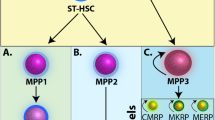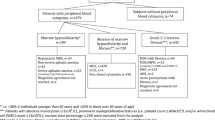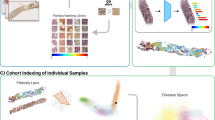Abstract
The DBSCAN clustering algorithm, an in-house method of unsupervised machine learning, was used to explore specific histotopographical features of the megakaryocytic lineage in the bone marrow biopsies of patients with JAK2- or CALR-mutated essential thrombocythemia and prefibrotic primary myelofibrosis. Ninety-five bone marrow biopsies of patients with essential thrombocythemia and primary myelofibrosis were investigated to assess the histotopography of megakaryocytes, specifically, the mean number of megakaryocytes in one cluster, as well as the mean number of clusters and megakaryocytes per 1 mm2 of section area. The logistic regression model was statistically significant: χ2 = 14.703, p = 0.023, Nagelkerke R2 = 19.6%. Analysis of the histotopographical features of megakaryocytes allowed correct differentiation between essential thrombocythemia and primary myelofibrosis in 71.6% cases. The differences in the histotopographical features of megakaryocytes in the bone marrow of with JAK2- or CALR-mutated essential thrombocythemia and primary myelofibrosis revealed by the DBSCAN clustering algorithm indicate that a relationship exists between the disease and the pattern of megakaryocytic lineage development that can be used to create a logistic regression model for differentiating these diseases.



Similar content being viewed by others
REFERENCES
D. A. Arber, A. Orazi, R. Hasserjian, et al., Blood 127 (20), 2391 (2016). https://doi.org/10.1182/blood-2016-03-643544
A. Alvarez-Larrán, A. Ancochea, M. García, et al., Br. J. Haematol. 166 (6), 911 (2014). https://doi.org/10.1111/bjh.12990
U. Gianelli, A. Bossi, I. Cortinovis, et al., Modern Pathol. 27, 814 (2014). https://doi.org/10.1038/modpathol.2013.196
T. Barbui, J. Thiele, F. Passamonti, et al., J. Clin. Oncol. 29, 3179 (2011). https://doi.org/10.1200/JCO.2010.34.5298
J. Thiele, H. M. Kvasnicka, L. Müllauer, et al., Blood 117, 5710 (2011). https://doi.org/10.1182/blood-2010-07-293761
A. B. Madelung, H. Bondo, I. Stamp, et al., Am. J. Hematol. 88, 1012 (2013). https://doi.org/10.1002/ajh.23554
B. S. Wilkins, W. N. Erber, D. Bareford, et al., Blood 111, 60 (2008). https://doi.org/10.1182/blood-2007-05-091850
M. Brousseau, E. Parot-Schinkel, M. P. Moles, et al., Histopathology 56, 758 (2010). https://doi.org/10.1111/j.1365-2559.2010.03545.x
T. Buhr, K. Hebeda, V. Kaloutsi, et al., Haematologica 97, 360 (2012). https://doi.org/10.3324/haematol.2011.047811
B. S. Wilkins, W. N. Erber, D. Bareford, et al., Blood 111 (1), 60 (2007). https://doi.org/10.1182/blood-2007-05-091850
S. M. Koopmans, F. J. Bot, K. H. Lam, et al., Am. J. Clin. Pathol. 136 (4), 618 (2011). https://doi.org/10.1309/ajcp2ug9sggwahua
M. Mejía-Ochoa, P. A. Acevedo Toro, and J. A. Cardona-Arias, BMC Cancer 19 (1), 590 (2019). https://doi.org/10.1186/s12885-019-5764-4
T. R. Merlinsky, R. L. Levine, and E. Pronier, Clin. Cancer Res. 25 (10), 2956 (2019). https://doi.org/10.1158/1078-0432.CCR-18-3777
J. Sander, M. Ester, H. P. Kriegel, and X. Xu, Data Mining Knowledge Discov. 2, 169 (1998). https://doi.org/10.1023/A:1009745219419
I. V. Konnov, O. A. Kashina, and E. I. Gilmanova, Uch. Zap. Kazan. Univ., Ser.: Fiz.-Mat. Nauki, 161 (3), 423 (2019). https://doi.org/10.26907/2541-7746.2019.3.423-437
Author information
Authors and Affiliations
Contributions
Z.P.A. and Yu.A.K. elaborated the study concept and and design; the material was collected and processed by Z.P.A., L.B.P., and A.I.L.; the manuscript was written by Z.P.A. and Yu.A.K. and edited by Yu.A.K.
Corresponding author
Ethics declarations
Conflict of interests. The authors declare that they have no conflict of interest.
Statement of compliance with standards of research involving humans as subjects. All procedures involving human participants were performed in accordance with the ethical standards of the 1964 Helsinki Declaration and its later amendments. Informed consent was obtained from all individual participants involved in the study.
Additional information
Translated by D. Timchenko
Abbreviations used: ET, essential thrombocythemia; PMF, primary myelofibrosis; MPN, myeloproliferative neoplasm; prePMF, prefibrotic stage of primary myelofibrosis.
Rights and permissions
About this article
Cite this article
Asaulenko, Z.P., Polushkina, L.B., Lepsky, A.I. et al. Morphological Differential Diagnosis of Primary Myelofibrosis and Essential Thrombocythemia with Computer Cluster Analysis of a Megakaryocytic Lineage in Myeloid Tissue. BIOPHYSICS 65, 676–680 (2020). https://doi.org/10.1134/S000635092004003X
Received:
Revised:
Accepted:
Published:
Issue Date:
DOI: https://doi.org/10.1134/S000635092004003X




